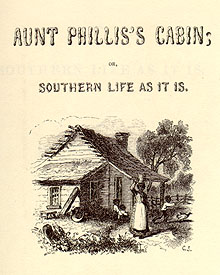 The Clifton Waller Barrett Collection |
Aunt Phillis's Cabin; or, Southern Life As It Is By Mary Henderson Eastman (Philadelphia: Lippincott, Grambo & Co, 1852) |
According to contemporary notices, this was probably the best-selling "anti-Tom" novel (though it sold between 20,000 and 30,000 copies, to 300,000 for Uncle Tom's Cabin). In most respects it is typical of the genre: it consists of a good deal of talk (often between slave owners and abolitionists) about the essential happiness of slaves in the South as compared to the inevitable sufferings of free blacks and the working classes in the North. Mary Henderson was born in 1818 in Warrenton, Virginia. In 1835 she married Seth Eastman, an artist and soldier; together they spent about a decade among the Dakota Indians, the subject of her first book. When she wrote Aunt Phillis she was living in Washington, D.C. In its text she identifies herself as "a member of one of the F.F.V's" (page 202), as a mother, and as a Christian. She quotes Uncle Tom's Cabin several times throughout the novel, to put her representation of slavery in direct opposition to Stowe's text, and her "Concluding Remarks" are a very unsentimental, even sarcastic critique of Stowe, but it is surprising how much the two texts have in common. Phillis herself, for example, has a lot in common with Tom.
 The Clifton Waller Barrett Collection |
Aunt Phillis's Cabin; or, Southern Life As It Is By Mary Henderson Eastman (Philadelphia: Lippincott, Grambo & Co, 1852) |
